Historical imagery
by Peter S. Dunham, Ph. D.
In these first private banknotes in Mexico archaeological and ethnic imagery, especially indigenous images, were used to help construct the modern national identity of Mexico. They were employed to replace a European vision where most Mexicans presented themselves as Europeans or criollos with a mestizo picture of the country, the Mexican people and the regimes.
These notes were released between 1865 and 1868, during the reign of Emperor Maximilian. They can be found in the six values, each with the same front, save for the denomination and colour. This is a glorious arrangement of images, spectacularly realized through the art of engraving, which, for the era, was of the highest technical quality. Many people believe that the backs of these notes were blank, but while this is true for the lowest denominations, the highest did have intricate security engravings on the reverse. The $50 note has a generally geometric design with many filigrees in pink: the $100 has a pink design with “CIEN” in tall green letters at the centre, and the $500 has a yellow background with “QUINIENTOS” in pink at the centre.
As the product of an English bank operating in Mexico under a French regime, the notes combine motifs of all three nationalities. In number, prominence, and variety of symbols, they favour the Mexican aspect: there are two Mexican vignettes, one to each side, there are Mexican plants in the four corners, the British coat of arms is in the centre and there are French fleurs-de-lis hanging from the banner surrounding the bank’s title and in the cartouches that surround the vignettes, but these are smaller, so secondary images. So all these nations are represented but in terms of position, the emphasis goes to Mexico.
Of the two Mexican vignettes, one is a scene of daily life on a ranch, whilst the other is easily recognizable as the Metropolitan cathedral of Mexico City. In the four corners are images of a yucca, plantain, cactus and agave. All these Mexican images were based on the lithographs in the book Mexico y Sus Alrededores … edited by Castro et al in various editions from 1855 and later. This was in its day the leading source of images of Mexico and its surroundings. The scene of daily life includes motifs from two lithographs in the series “Trajes Mexicanos”, a ranch and a market view. The horse and rider, standing man, and cactus are from the ranch engraving, whilst the woman with shawl and billowing skirt is taken from a figure in the engraving of the market.
 |
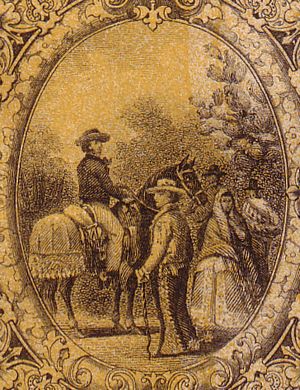 |
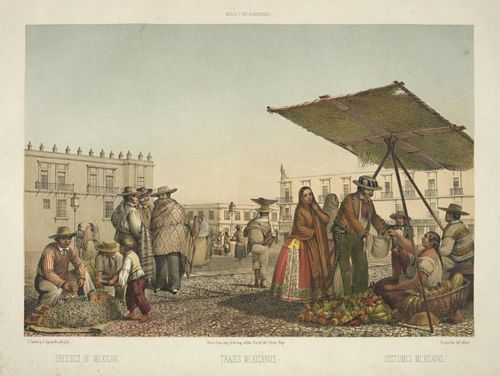 |
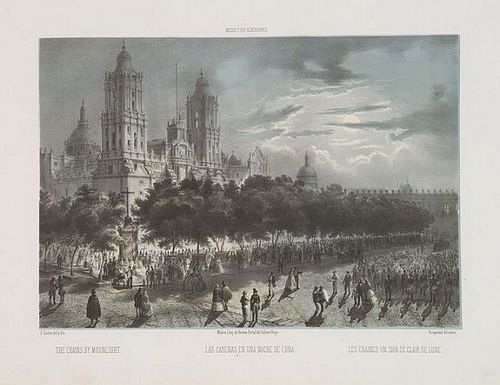 |
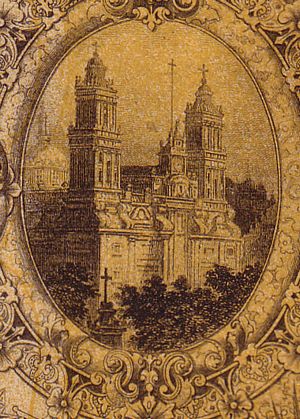 |
The cathedral view is clearly adapted from “las cadenas en una noche de luna”, Castro’s lithograph of the main plaza of Mexico City, the Zocalo. The angle is identical, as are the lighting and shadows, but the cross in the corner is shifted a little and the elevation of the trees has been reduced to expose more of the façade.
The plants on the notes have been adopted from the frontispiece of Castro et al. Thus
- highly similar representations of the same plants appear on both frontis and note
- the placement of the plants is identical on both the notes and the frontis
- all are of the same species.
The notes and lithograph of Castro agree down to the minutiae of the minor plants, so
- the cacti on both the notes and lithograph have at their feet the same plants with large wide leaves, likely pumpkins or squashes
- the lithographed cactus supports a climbing plant that resembles the vine on the note. The banknote’s engraver interpreted these as grapes since he was not familiar with Mexican plants but in fact they are not grapes but passiflora, a common plant endemic to Mexico.
In fact the notes and lithographs give us enough detail to be able to identify the main plants as typical varieties associated with Mexico, above all the central highlands, namely
| ● the yucca is Yucca filifera Chabaud (“izote”), only found in the central highlands and north | 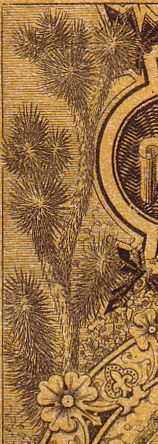 |
 |
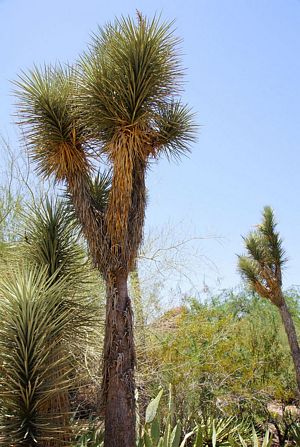 |
| ● the plantain is Ensete ventricosum (“platano mexicano”), Old World in origin but abundant in the central highlands | 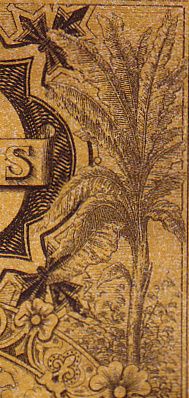 |
 |
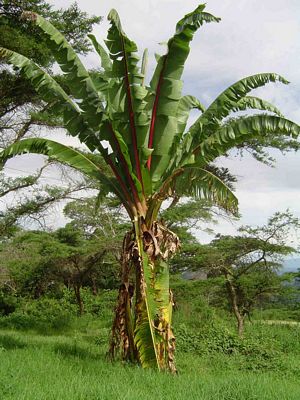 |
| ● the cactus is Opuntia streptacantha Lem (“nopal cardon”), from the central highlands and the “norte chico”, so readily identified with Mexico that it appears on the Mexican seal |  |
 |
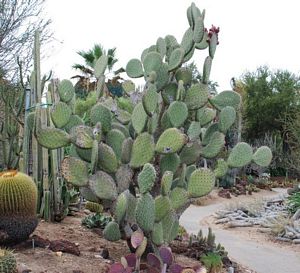 |
| ● the agave is Agave salmiana Otto ex Salm-Dyck (“maguey de pulque”), from the central highlands | 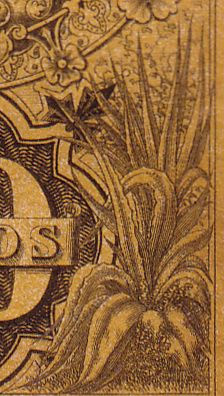 |
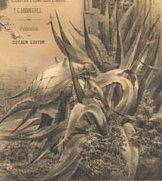 |
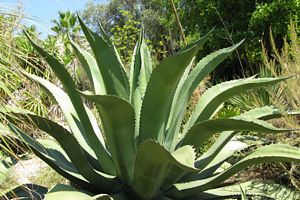 |
Just as interesting as what is pictured on these notes is what is left off as there are the elements in Castro that were left out, and left out intentionally. The motifs that do not appear on the Maximilian notes are as important as those that do. If you put yourself into the position of both the bank, from England, and of Maximilian, who has a French regime in Mexico, the last thing that you would want to do is put on your banknotes anything that was going to stir up opposition. So two key themes are excluded – the indigenous and the nationalist.
There are indigenous images on the Castro frontispiece that refer to native patrimony. Two kinds of native images were omitted from the notes, namely:
| ● Indigenous figures – the native woman on the lower left and the tlachiquero (pulque juice collector) on the lower right. In the colour version of the frontis the woman is definitely garbed in traditional Mexican attire; too dangerous as likely to stir up native identity especially among the large mestizo population. The tlachiquero is an iconic figure that Mexicans would have identified with so closely that putting on the notes might have been a step too far. | 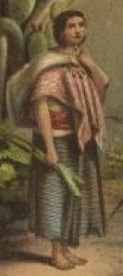 |
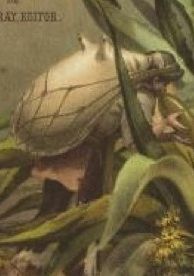 |
| ● Archaeological Remains – the carved idols at the top centre and lower left, not copied after any particular idol but clearly inspired by native Mexican archaeological sculpture. These would be considered a little bit too dangerous in terms of stirring up Mexican nationalism. | 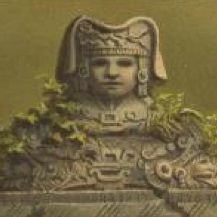 |
 |
We can note that later notes immediately after this issue were covered in this kind of imagery, so this is not an accident. Porfirio Díaz had an agenda to promote Mexican identity and to make Mexico a mestizo country, not one that was orientated towards its European identity, so indigenous and archaeological representations were common a little later on sovereign Porfirian notes.
Maximilian notes also excluded overt symbols of nationalism and Mexican autonomy. Such images are again frequent on Porfirian notes and include many representations of Hidalgo,the Mexican coat-of-arms, the Pileus or Phrygian cap of liberty, Juárez (who of course was not yet the great opposition leader that he was to become) and Morelos.
It should be remembered that these Maximilian notes were not directed at the lower class, but circulated among people with resources, the elite, many of whom identified with Europe, and their messages were targeted there too. The average Mexican would have needed fractional currency or at most one or two peso notes, whilst these larger denomination notes were made primarily for commercial and bank transactions.
(based on a presentation by Peter S. Dunham, Ph. D. In his presentation Peter thanked José Antonio Batiz Vasquez and Rogelio Charteris Reyes of the Sociedad Numismático de México, Colin Cohen of the British Association of Paper Historians, Dr. Gerrit Davidse of the Missouri Botanical Garden, Dr. Abisal Josue García Mendoza of the National Botanical Gardens, Mexico, Salvador Sotomayor Jiménez, an investigator and collector, Teresa Tortella of the Archives of the Bank of Spain (retired), Duane Douglas, Cory Frampton and Kent Ponterio)
